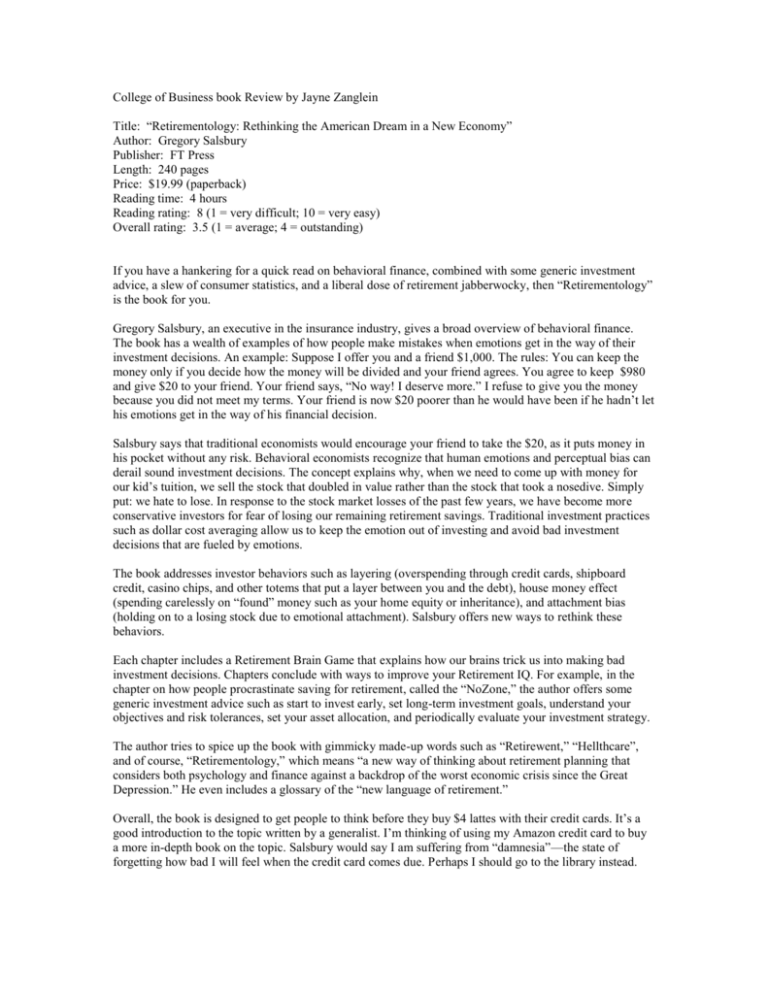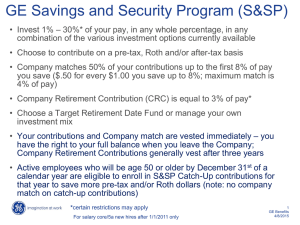Retirementology: Rethinking the American Dream in a New Economy
advertisement

College of Business book Review by Jayne Zanglein Title: “Retirementology: Rethinking the American Dream in a New Economy” Author: Gregory Salsbury Publisher: FT Press Length: 240 pages Price: $19.99 (paperback) Reading time: 4 hours Reading rating: 8 (1 = very difficult; 10 = very easy) Overall rating: 3.5 (1 = average; 4 = outstanding) If you have a hankering for a quick read on behavioral finance, combined with some generic investment advice, a slew of consumer statistics, and a liberal dose of retirement jabberwocky, then “Retirementology” is the book for you. Gregory Salsbury, an executive in the insurance industry, gives a broad overview of behavioral finance. The book has a wealth of examples of how people make mistakes when emotions get in the way of their investment decisions. An example: Suppose I offer you and a friend $1,000. The rules: You can keep the money only if you decide how the money will be divided and your friend agrees. You agree to keep $980 and give $20 to your friend. Your friend says, “No way! I deserve more.” I refuse to give you the money because you did not meet my terms. Your friend is now $20 poorer than he would have been if he hadn’t let his emotions get in the way of his financial decision. Salsbury says that traditional economists would encourage your friend to take the $20, as it puts money in his pocket without any risk. Behavioral economists recognize that human emotions and perceptual bias can derail sound investment decisions. The concept explains why, when we need to come up with money for our kid’s tuition, we sell the stock that doubled in value rather than the stock that took a nosedive. Simply put: we hate to lose. In response to the stock market losses of the past few years, we have become more conservative investors for fear of losing our remaining retirement savings. Traditional investment practices such as dollar cost averaging allow us to keep the emotion out of investing and avoid bad investment decisions that are fueled by emotions. The book addresses investor behaviors such as layering (overspending through credit cards, shipboard credit, casino chips, and other totems that put a layer between you and the debt), house money effect (spending carelessly on “found” money such as your home equity or inheritance), and attachment bias (holding on to a losing stock due to emotional attachment). Salsbury offers new ways to rethink these behaviors. Each chapter includes a Retirement Brain Game that explains how our brains trick us into making bad investment decisions. Chapters conclude with ways to improve your Retirement IQ. For example, in the chapter on how people procrastinate saving for retirement, called the “NoZone,” the author offers some generic investment advice such as start to invest early, set long-term investment goals, understand your objectives and risk tolerances, set your asset allocation, and periodically evaluate your investment strategy. The author tries to spice up the book with gimmicky made-up words such as “Retirewent,” “Hellthcare”, and of course, “Retirementology,” which means “a new way of thinking about retirement planning that considers both psychology and finance against a backdrop of the worst economic crisis since the Great Depression.” He even includes a glossary of the “new language of retirement.” Overall, the book is designed to get people to think before they buy $4 lattes with their credit cards. It’s a good introduction to the topic written by a generalist. I’m thinking of using my Amazon credit card to buy a more in-depth book on the topic. Salsbury would say I am suffering from “damnesia”—the state of forgetting how bad I will feel when the credit card comes due. Perhaps I should go to the library instead. Jayne Zanglein is a professor of business law in the College of Business at Western Carolina University. She specializes in pension investments and employee benefits. For previously reviewed books, visit us at our website at www.wcu.edu/cob/.







